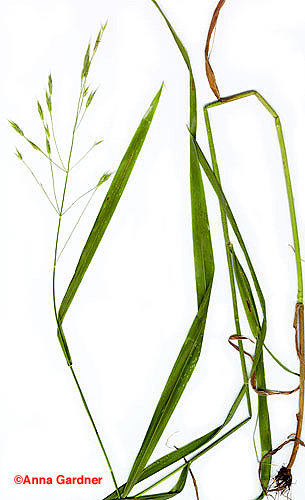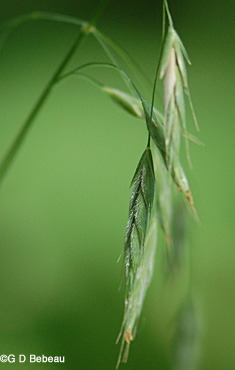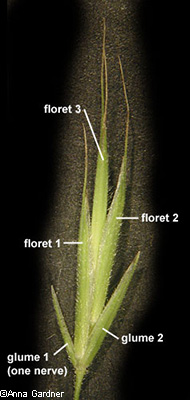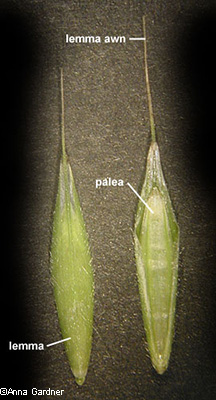The Friends of the Wildflower Garden, Inc.
Grasses of the Eloise Butler Wildflower Garden
The oldest public wildflower garden in the United States

Common Name
Hairy Woodland Brome (Canada Brome)
Scientific Name
Bromus pubescens L.
Plant Family
Poaceae (Grasses)
Garden Location
Woodland
Prime Season
June to August
Grass structure and definitions - PDF from Oregon State University
Hairy Woodland Brome is a native perennial grass, not tufted, with stems that have 5 to 7 nodes that are usually hairy. Stems (culms) are erect and can be 24 to 48 inches tall.
Leaves: Leaf blades are 5 to 13 inches long and up to 5/8 inch wide (15 mm), flat with both surfaces either smooth or hairy.
Sheath throats and collars: Leaf collars can be smooth or hairy, auricles are absent, leaf sheaths are closed with fine retrorse hair. Ligules are very short (0.5-2 mm), obtuse to truncate, but without hair.
The inflorescence is a panicle, up to 10 inches long, of open shape and usually nodding.
Flowers & spikelets: Spikelets are 15 to 30 mm long, somewhat elliptic to lanceolate in shape with 5 to 10 florets. Both lower and upper glumes are veined (1 vein usually on the lower and 3 on the upper), the upper glume longer (5-10 mm) and both usually have fine hair. Lemmas are 8 to 12 mm long, mostly lanceolate in shape, rounded over the midvein, backs and margins usually with hair. Florets have 2 anthers and awns that are straight, 4 to 7 mm long.
Habitat: Hairy Woodland Brome grows in shaded, moist upland forests, fields, roadsides, stream banks and needs shade. Unlike Smooth Brome it does not have rhizomes.
Names: The genus Bromus, is derived from the Greek bromos, referring to oats, as the flowering heads of this genus resemble oats somewhat. The species name pubescens means with soft or downy hair. The author name for the plant classification, 'L.' refers to Carl Linnaeus (1707-1778), Swedish botanist and the developer of the binomial nomenclature of modern taxonomy.
Comparisons: Identifying characteristics are the drooping flower panicles, closed leaf sheaths, and the usually hairy stems, stem nodes, leaf sheaths and the glumes which usually have fine hair. There are three species of Bromus in the Garden. See bottom of page for an ID key.


Above: Note the typical drooping flower panicles. 2nd photo - A complete example of the plant. Photo ©Anna Gardner, Iowa State University

Below: Note the hairy stem and leaf sheath and, in this example, the margins and lower surfaces of the blade.

Below: Note the fine hair on the glumes and lemmas; the awns are just developing.


Below: Detail of the florets and lemmas. Photos ©Anna Gardner, University of Iowa.


Below: A maturing spikelet.

BELOW: A comparison of the three species of Bromis at Eloise Butler.
| Species | B. inermis | B. latiglumis | B. pubescens |
| Smooth Brome | Earlyleaf Brome | Hairy Woodland Brome | |
| Rhizomes present | Yes | No | No |
| Stems (all are erect) | |||
| Height | 1.5 to 4 feet | 3 to 5 feet | 2 to 4 feet |
| # of stem nodes | 3-5 | 9-20 | 5-7 |
| Stems hairy? | usually not | usually not | usually |
| Leaf sheaths hairy? | usually not | can be, throats and collars densely hairy | usually, backward bent |
| Ligules | to 3mm. smooth | 0.8 to 1.4mm hairy | 0.5 to 2mm smooth |
| Leaf Blades | |||
| Length | 4 - 14", flat | 8 - 12", flat | 5 - 13", flat |
| Width | to 15mm (5/8") | to 15mm (5/8") | to 15mm (5/8") |
| Hair on blades | usually not | usually not | can be with or without |
| Special feature | 2 prominent flanges on collar | ||
| Panicles | 10 -20 cm long (4 to 8") | 10 - 22 cm long | 10 - 25 cm long |
| open | open | open | |
| erect | nodding | usually nodding | |
| Panicle branches | ascending or spreading | ascending or spreading | spreading, sometimes ascending, usually drooping |
| Spikelets | 20-40 mm long, sometimes purplish, with 8-10 florets | 15-30mm long with 4-9 florets | 15-30mm long with 5-10 florets. |
| Glumes with or without hair | without | either way | usually soft fine hair |
| Lemmas | usually without hair | longhair on margins | margins usually hairy |
| Awns present | absent or to 3mm | 3 - 4.5mm, straight | 4-7mm, straight. |
Hairy Woodland Brome or Canada Brome is a native perennial growing from the Great Plains to the east coast, from the lower Canadian Provinces south to the Gulf. In Minnesota it is the least found of the three Bromus species that are in the Garden - found mostly in the SE quadrant of the state to just north of the metro area; plus a few scattered counties in the SW and NW quadrant. There are 52 species of Bromus in the United States, 28 native and 24 introduced. Eight of those species are in Minnesota - 4 native and 4 introduced. Worldwide the estimate is 100-400 species. The three species in the Garden are outlined in the ID key above.
Return to -- Site Plan/Archive Index --or-- List of Common Plant Names -- or -- List of Scientific Names -- or --Home Page - - - Back to top.
References: Plant characteristics are generally from sources 1A, 32, W2, W3, W7 & W8 plus others as specifically applied. Distribution principally from W1, W2 and 28C. Planting history generally from 1, 4 & 4a. Other sources by specific reference. See Reference List for details.
 Identification booklet for most of the flowering forbs and small flowering shrubs of the Eloise Butler Wildflower Garden. Details Here.
Identification booklet for most of the flowering forbs and small flowering shrubs of the Eloise Butler Wildflower Garden. Details Here.
©2014
Friends of the Wildflower Garden, Inc. Text and photos are by G. D. Bebeau unless otherwise credited. "www.friendsofeloisebutler.org"
101022